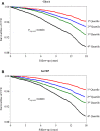A novel protein glycan biomarker and future cardiovascular disease events
- PMID: 25249300
- PMCID: PMC4323825
- DOI: 10.1161/JAHA.114.001221
A novel protein glycan biomarker and future cardiovascular disease events
Abstract
Background: Glycosylated proteins partake in multiple cellular processes including inflammation. We hypothesized that GlycA, a novel biomarker of protein glycan N-acetyl groups, is related to incident cardiovascular disease (CVD), and we compared it with high-sensitivity C-reactive protein (hsCRP).
Methods and results: In 27 491 initially healthy women, baseline GlycA was quantified by nuclear magnetic resonance spectroscopy and hsCRP by an immunoturbidimetric assay. During median follow-up of 17.2 years, 1648 incident CVD events occurred (myocardial infarction, ischemic stroke, coronary revascularization, and CVD death). GlycA and hsCRP were moderately correlated (Spearman r=0.61, P<0.0001). In Cox regression models that included age, ethnicity, smoking, blood pressure, medications, menopausal status, body mass index, and diabetes, hazard ratios for CVD across quartiles 1 to 4 of GlycA were 1.00, 1.10 (95% CI, 0.92 to 1.30), 1.34 (95% CI, 1.13 to 1.58), and 1.64 (95% CI, 1.39 to 1.93), similar to hsCRP, for which hazard ratios were 1.00, 1.18 (95% CI, 0.99 to 1.41), 1.35 (95% CI, 1.14 to 1.61), and 1.75 (95% CI, 1.47 to 2.09) (both Ptrend<0.0001). Associations were attenuated after additionally adjusting for lipids: the hazard ratio of quartile 4 versus 1 for GlycA was 1.23 (95% CI, 1.04 to 1.46; Ptrend=0.002) and for hsCRP was 1.44 (95% CI, 1.20 to 1.72; Ptrend<0.0001). Further adjustment for the other biomarker resulted in a hazard ratio of quartile 4 versus 1 for GlycA of 1.03 (95% CI, 0.85 to 1.24; Ptrend=0.41) and for hsCRP of 1.29 (95% CI, 1.06 to 1.56; Ptrend=0.001).
Conclusions: In this prospective study of initially healthy women, baseline GlycA was associated with incident CVD, consistent with a possible role for protein glycans in inflammation and CVD.
Clinical trial registration url: http//clinicaltrials.gov/. Unique identifier NCT00000479.
Keywords: cardiovascular; epidemiology; glycoproteins; inflammation.
© 2014 The Authors. Published on behalf of the American Heart Association, Inc., by Wiley Blackwell.
Figures



References
-
- Marino K, Bones J, Kattla JJ, Rudd PM. A systematic approach to protein glycosylation analysis: A path through the maze. Nat Chem Biol. 2010; 6:713-723. - PubMed
-
- van Kooyk Y, Rabinovich GA. Protein‐glycan interactions in the control of innate and adaptive immune responses. Nat Immunol. 2008; 9:593-601. - PubMed
-
- Arnold JN, Wormald MR, Sim RB, Rudd PM, Dwek RA. The impact of glycosylation on the biological function and structure of human immunoglobulins. Ann Rev Immuno. 2007; 25:21-50. - PubMed
-
- Ohtsubo K, Marth JD. Glycosylation in cellular mechanisms of health and disease. Cell. 2006; 126:855-867. - PubMed
Publication types
MeSH terms
Substances
Associated data
Grants and funding
LinkOut - more resources
Full Text Sources
Other Literature Sources
Medical
Research Materials

